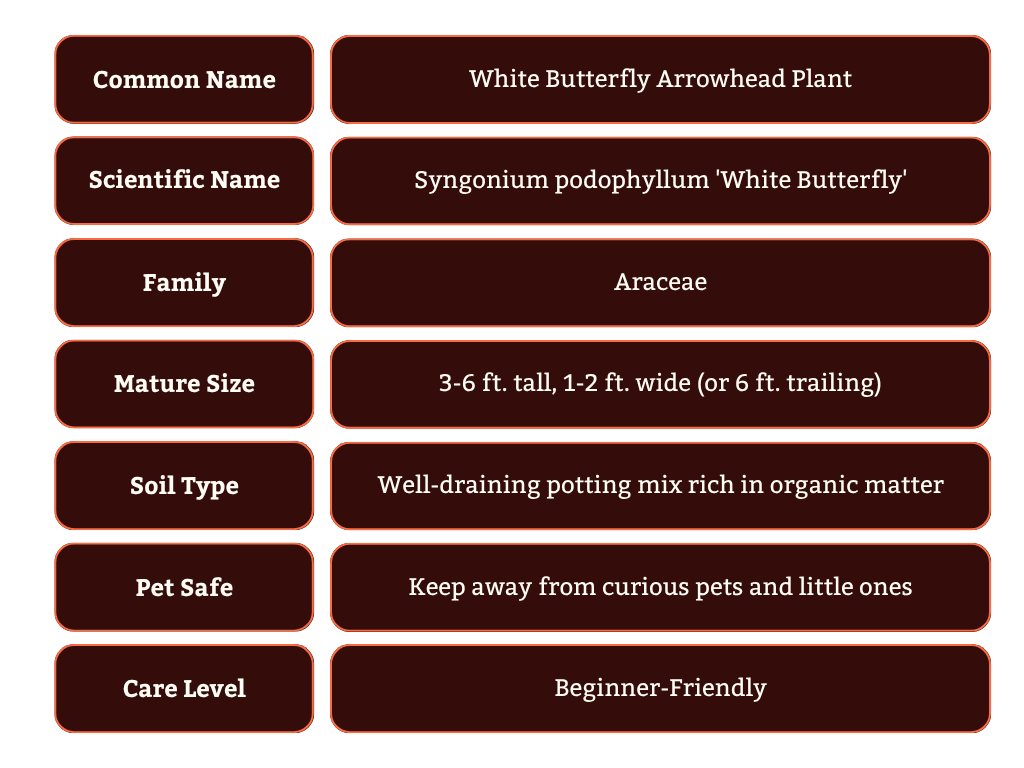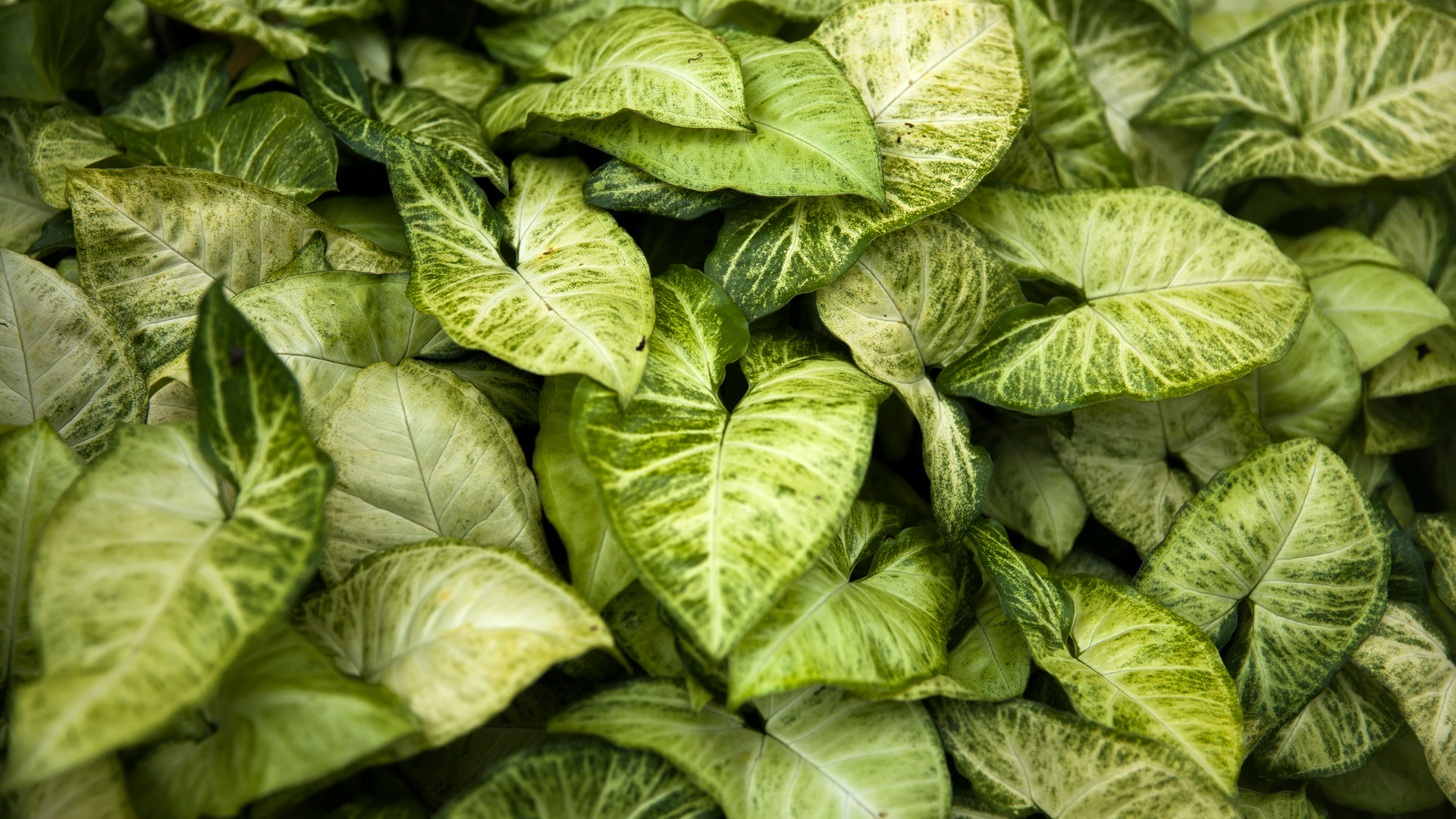White Butterfly Arrowhead Plant Care Guide
Your complete guide to nurturing a thriving White Butterfly Arrowhead Plant
Your Plant's Story
This stunning White Butterfly Arrowhead Plant started its journey as a cutting from one of our vigorous mother plants in our greenhouse. Each plant carries the transformative energy and adaptable spirit of its parent, carefully propagated and nurtured until ready to bring that shape-shifting magic to your space.
The Magic: This enchanting shape-shifter starts with arrow-shaped leaves that completely transform as it matures - like watching your plant grow up and develop its own personality! The creamy white and green variegation creates a butterfly effect that's absolutely mesmerizing.
From rainforest floors to your space: Your White Butterfly ancestors evolved in the humid rainforests of Mexico, Costa Rica, and Brazil, developing the ability to change leaf shape and vine or climb as they reach for light filtering through the forest canopy.
Hand-selected for you: Every Dirt Witch White Butterfly Arrowhead Plant is chosen for its beautiful variegation, healthy growth patterns, and that special adaptive energy that makes them perfect companions for plant parents who love watching growth and change.
At a glance
Keep Away From Pets
Keep away from curious pets and little ones - mildly toxic if ingested
Bright Indirect Light
Bright but gentle light keeps those gorgeous colors vibrant
Beginner-Friendly
Fast-growing beauty that's forgiving and adaptable
Plant Overview
Essential Care
Light
Perfect placement: Bright, indirect light for 4-6 hours daily - think of that perfect filtered sunlight that keeps colors vibrant without harsh rays
Best spot: Near a bright window with sheer curtains, or a few feet back from south/west windows
Morning sun okay: Can handle gentle morning light, but protect from intense afternoon sun
Avoid: Direct sun (will scorch those delicate white markings) or deep shade (reduces beautiful variegation)
Too little light signs: Less white variegation, greener leaves, slower growth
Perfect light signs: Crisp white and green contrast, steady new leaf production, compact growth
Watering
Finding the rhythm: This adaptable beauty likes consistently moist soil but never soggy - let the top inch dry out between waterings
Spring/Summer: Weekly or when top inch feels dry (they're more forgiving than you think!)
Fall/Winter: Every 1-2 weeks as growth slows and water needs decrease
Pro tip: Better to slightly underwater than overwater - these plants can handle some drought but hate wet feet
Signs it needs water: Top inch of soil feels dry, leaves may look slightly less perky
Signs of overwatering: Yellow leaves, mushy stems, soil that stays wet for days
Humidity
Creating the vibe: 60%+ humidity is ideal, but they're surprisingly adaptable to normal household humidity
Easy ways to boost humidity:
Place in naturally humid spots like bright bathrooms or kitchens
Use a pebble tray with water for gentle moisture
Group with other tropical plants to create a humidity microclimate
Misting okay: Unlike some plants, these don't mind gentle misting on leaves
Temperature
Comfort zone: 65-85°F - comfortable indoor temperatures year-round
Avoid: Cold drafts, sudden temperature changes, anything below 60°F
Winter care: Keep away from heating vents and cold windows
Perfect range: Steady warmth that mimics their tropical rainforest origins
Soil & Feeding
Soil: Well-draining potting mix rich in organic matter - standard potting soil works great
Feeding schedule:
Growing season (Spring/Summer): Monthly with diluted balanced fertilizer
Dormant season (Fall/Winter): Reduce to every 2-3 months or skip entirely
Fertilizer type: Balanced liquid fertilizer diluted to half strength
Monthly Care Ritual
Every month, create a moment to connect with your shape-shifter:
Check soil moisture and water when the top inch feels dry (these are forgiving if you occasionally forget!)
Inspect for pests, especially under leaves and in leaf joints
Gently dust those gorgeous variegated leaves with a soft cloth (they'll reward you with better photosynthesis)
Decide if you want it to climb (add support) or stay bushy (pinch growing tips)
Remove any spent or damaged leaves that have completed their journey
Rotate pot 1/4 turn for even growth and light exposure
Growing season bonus ritual (Spring/Summer):
Offer diluted fertilizer monthly to support that fast, adaptive growth
Consider light pruning to encourage bushier growth or train up a support
Check if repotting is needed (every 1-2 years - these grow fast!)
Propagation & Repotting Magic
When Your Plant Needs More Space
Every 1-2 years, or when your White Butterfly starts sending you these signals:
Roots are coming out of the drainage holes like they're ready to explore
Growth has slowed despite good care
Water runs through very quickly without the soil absorbing it
The plant has clearly outgrown its current space. Think of repotting as giving your shape-shifter room to really express its climbing or trailing nature!
The Magic of Making More Plants
Best method: Stem cuttings (incredibly easy and fast!)
There's something absolutely magical about propagating arrowhead plants because they root so reliably and quickly. Here's how to work this adaptive magic:
Stem cutting method:
Cut a 4-6 inch piece that includes at least one node (where leaves grow from)
Look for aerial roots if possible - they make rooting even easier
Root in water for 2-4 weeks until roots are 2+ inches long
Plant in well-draining soil and keep lightly moist until established
Pro tip: These root so fast in water you can almost watch it happen!
Pro tip from one plant-obsessed person to another: Arrowhead plant propagation is seriously addictive because it's so foolproof and fast! You'll soon have baby arrowheads rooting all over your kitchen. They make incredible gifts and are perfect for trading with other plant people. Your plant's offspring continue spreading that adaptive, shape-shifting magic to new homes, creating connections that grow and change just like the plants themselves!
Common Visitors & How to Handle Them
-
The microscopic web makers: These tiny visitors show up when the air is too dry - they're telling you to increase humidity around your arrowhead.
Signs: Fine webbing on leaves, stippled appearance, tiny moving specks
Natural remedy: Increase humidity, wipe leaves clean with a damp cloth, spray with neem oil solution
-
The cottony crashers: These white, fluffy visitors love to hide in leaf joints and stem crevices - they're attracted to stressed plants.
Signs: White cottony clusters in leaf joints and where stems meet
Gentle removal: Dab with rubbing alcohol on cotton swab, improve air circulation, check care routine
-
The sap suckers: These tiny green or black bugs cluster on new growth, drawn to the sweet sap of healthy arrowheads.
Signs: Small bugs clustered on new leaves and stems, sticky honeydew on leaves
Natural approach: Rinse off gently with water, spray with insecticidal soap, increase air circulation
FAQ & Plant Wisdom
-
Your plant is asking for more light! Variegated plants need bright light to maintain their white markings. The green parts of the plant photosynthesize more efficiently, so in low light, it produces more green. Move it closer to a bright window (but still avoid direct sun).
-
Brown leaves usually mean watering issues!
Check if you're underwatering (the soil feels bone dry) or if poor drainage is causing root problems. These plants like consistent moisture but never soggy conditions.
-
Pinch or cut the growing tips regularly! This encourages the plant to branch out and stay compact rather than getting leggy.
Do this in spring/summer for best results, and your plant will reward you with fuller, bushier growth.
-
Both are beautiful! Young plants naturally stay bushy, but as they mature, they want to climb. You can train them up a moss pole or trellis for that jungle vibe, or let them trail from a hanging basket.
Follow your space and aesthetic preferences!
-
This usually means insufficient light. Increase light gradually, and prune off the solid green growth to encourage the plant to produce more variegated leaves.
Think of it as guiding your plant back to its colorful personality!
-
These are moderate to fast growers! In good conditions, expect new leaves regularly during spring and summer. They're much faster than prayer plants but not quite as vigorous as pothos - a perfect middle ground.
-
Absolutely!
This is the coolest feature of arrowhead plants. Young leaves are arrow-shaped, but as the plant matures and starts climbing, leaves become more lobed and divided. It's like watching your plant grow up and develop its adult personality!
-
Your plant is probably getting too much direct light! Move it to a spot with bright but filtered light. Arrowhead plants prefer that gentle, diffused light that won't bleach their beautiful variegation.
-
Every 1-2 years or when it's clearly outgrown its pot. These plants grow relatively quickly, so they appreciate fresh soil and a bit more space. Spring is the perfect time for repotting when their growth energy is high.
Still need help?
Having trouble with your White Butterfly Arrowhead Plant? We are here to help!
Email us at hello@dirt-witch.com with photos of any issues
Send us a DM on Instagram @dirtwitch with your questions
Remember: White Butterfly Arrowhead Plants are wonderfully adaptable and forgiving. Trust your instincts, observe how your plant's leaves change over time, and embrace the shape-shifting journey this beautiful plant will take you on!
Happy growing!





